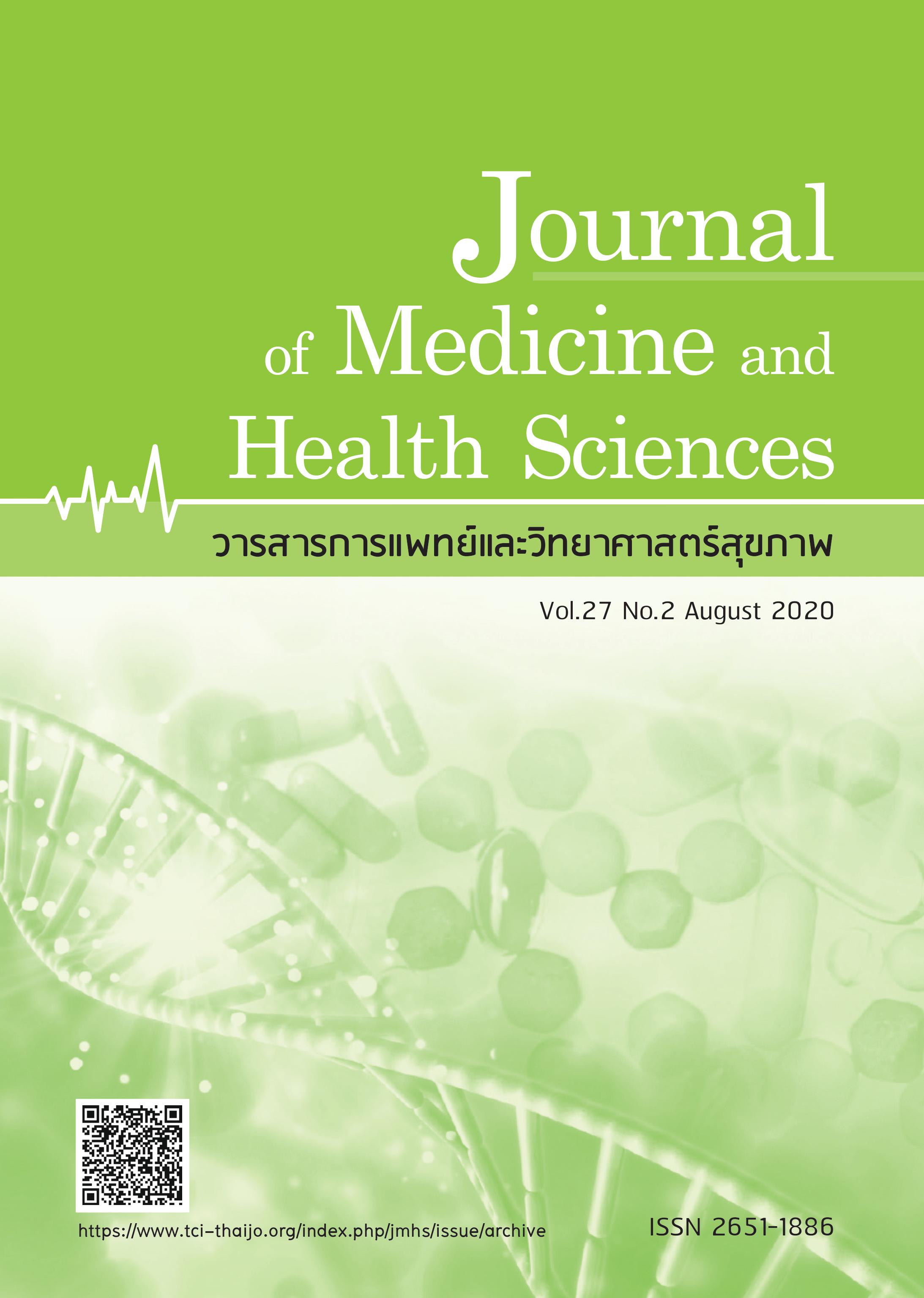Cysticidal efficacy of methanolic extract from Jatropha curcas on Acanthamoeba spp.
Keywords:
Acanthamoeba spp., Jatropha curcas, cysticidal, J. curcas root, cysticidal efficacy, methanolic extractsAbstract
Introduction: Acanthamoeba is an opportunistic protozoon causing granulomatous amoebic encephalitis and amoebic keratitis (AK). Humans can be infections with a serious symptom especially contact lens wearers and immunocompromised patients. This study aimed to evaluate the cysticidal efficacy of methanolic extract of Jatropha curcas on Acanthamoeba spp. Acanthamoeba cyst-containing suspension of 7 x 104 cysts/ml was treated with methanolic extract of J. curcas and 1% sodium hypochlorite for 1 to 24 hours to determine the minimal cysticidal concentration of each disinfectant. Inverted phase-contrast microscopy was used to observe the morphologic changes. The minimum concentration methanolic extract of J. curcas root for 12 and 24 hours were 400 and 300 µg/ml, respectively. And, lethal concentration values which causes the death of 50% for 12 and 24 hours were 303 and 245 µg/ml respectively. The results show that, methanolic extract of J. curcas root can make a damage to Acanthamoeba cyst.
References
Marciano-Cabral F, Cabral G.Acanthamoeba spp. as agents of disease in humans. Clin Microbiol Rev 2003;16(2):273-307.
Pussard M. Morphology of free-living amoebas. Importance and principles of study. Ann Soc Belg Med Trop 1974;54(4-5): 249-57.
Ledee DR, Booton GC, Awwad MH, et al. Advantages of using mitochondrial 16S rDNA sequences to classify clinical isolates of Acanthamoeba. Invest Ophthalmol Vis Sci 2003;44(3):1142-9.
Gast RJ, Ledee DR, Fuerst PA, Subgenus systematics of Acanthamoeba: four nuclear 18S rDNA sequence types.
J Eukaryot Microbiol 1996;43(6):498-504.
Sell JJ, Rupp FW, Orrison WW, Jr. Granulomatous amebic encephalitiscaused byAcanthamoeba. Neuroradiology
;39(6):434-6.
Flores-Maldonado C, Gonzalez-Robles A, Salazar-Villatoro L, et al. Acanthamoeba (T4) trophozoites cross the MDCK epithelium without cell damage but increase paracellular permeability and transepithelial resistance by modifying tight junction composition. Exp Parasitol 2017;183:69-75.
Memari F, Niyyati M, Joneidi Z. Pathogenic Acanthamoeba T4 Genotype Isolated from Mucosal Tissue of a Patient with HIV Infection: A Case Report. Iran J Parasitol 2017;12(1):143-7.
Gullett J, Mills J, Hadley K, et al. Disseminated granulomatous acanthamoeba infection presenting as an unusual skin lesion. Am J Med 1979;67(5):891-6.
Tan B, Weldon-Linne CM, Rhone DP, et al. Acanthamoeba infection presenting as skin lesions in patients with the acquired immunodeficiency syndrome. Arch Pathol Lab Med 1993;117(10):1043-6.
Walochnik J, Aichelburg A, Assadian O, et al. Granulomatous amoebic encephalitis caused by Acanthamoeba
amoebae of genotype T2 in a human immunodeficiency virus-negative patient. J Clin Microbiol 2008;46(1):338-40.
Claerhout I, Kestelyn P. Acanthamoeba keratitis: a review. Bull Soc Belge Ophtalmol 1999;274:71-82.
Seilhamer JJ, Byers TJ. Mutants of Acanthamoeba castellanii resistant to erythromycin, chloramphenicol, and
oligomycin. J Protozool 1978;25(4):486-9.
Iovieno A, Oechsler RA, Ledee DR, et al. Drug-resistant severe Acanthamoeba keratitis caused by rare T5 Acanthamoeba genotype. Eye Contact Lens 2010;36(3): 183-4.
Namuli A, Abdullah N, Sieo CC, et al. Phytochemical compounds and antibacterial activity of Jatropha
curcas Linn. extracts. J Med Plants Res 2011;5(16):3982-90.
Sangsuwon C, Jirujchariyakul W, Roongruangchai K. Chemical Constituents and Antiamoebic of Methanolic Fraction from Peperomia pellucida (Linn.) Kunth. Appl Mech Mater 2014;709:417-21.
Ahmad T, Shukla K, Sharma A. K. Effect of chlorine (disinfectant) on viability of pathogenic free-living amoebae. Indian J Fundamental Appl Life Sci 2012;2(2); 132-7.



